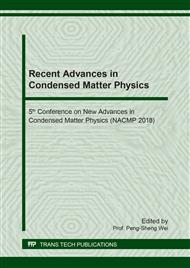[1]
J. Kim, A. Paul, P. A. Crowell, S. J. Koester, S. S. Sapatnekar, J. P. Wang, and C. H. Kim, Spin-based computing: device concepts, current status, and a case study on a high-performance microprocessor, Proc. IEEE, 103 (2015) 106-130.
DOI: 10.1109/jproc.2014.2361767
Google Scholar
[2]
W. Kang, Y. Ran, W. F. Lv, Y. G. Zhang, and W. S. Zhao, High-speed low-power magnetic non-volatile flip-flop with voltage-controlled magnetic anisotropy assistance, IEEE Magn. Lett. 7 (2016) 3106205.
DOI: 10.1109/lmag.2016.2604205
Google Scholar
[3]
J. S. Moodera, L. R. Kinder, T. M. Wong, and R. Meservey, Large magnetoresistance at room temperature in ferromagnetic thin film tunnel junctions, Phys. Rev. Lett. 74 (1995) 3273-3276.
DOI: 10.1103/physrevlett.74.3273
Google Scholar
[4]
P. Xu, K. Xia, C. Z. Gu, L. Tang, H. F. Yang, and J. J. Li, An all-metallic logic gate based on current-driven domain wall motion, Nature Nanotechnol. 3 (2008) 97-100.
DOI: 10.1038/nnano.2008.1
Google Scholar
[5]
B. Behin-Aein, D. Datta, S. Salahuddin, and S. Datta, Proposal for an all-spin logic device with built-in memory, Nature Nanotechnol. 5 (2010) 266-270.
DOI: 10.1038/nnano.2010.31
Google Scholar
[6]
S. C. Chang, S. Manipatruni, D. E. Nikonov, I. A. Young, and A. Naeemi, Design and analysis of Si interconnects for all-spin logic, IEEE Trans. Magn. 50 (2014) 3400513.
DOI: 10.1109/tmag.2014.2325536
Google Scholar
[7]
M. Sharad, C. Augustinein, G. Panagopoulos, K. Roy, Spin Based Neuron-Synapse Module for Ultra Low Power Programmable Computational Networks. The 2012 International Joint Conference on Neural Networks (IJCNN), Brisbane, Australia. (2012) 1-7.
DOI: 10.1109/ijcnn.2012.6252609
Google Scholar
[8]
R. M. Iraei, S. Manipatruni, D. E. Nikonov, I. A. Young, A. Naeemi, Electrical-spin transduction for CMOS-Spintronic interface and long-range interconnects, IEEE J. Explor. Solid-State Comput. Dev. Circ. 3 (2017) 47-55.
DOI: 10.1109/jxcdc.2017.2706671
Google Scholar
[9]
J. C. Slonczwski, Current-driven excitation of magnetic multi-layers, J. Magn. Magn. Mater. 159 (1996) L1-L7.
Google Scholar
[10]
A. Brataas, G. E. W. Bauer, and P. J. Kelly, Non-collinear magnetoelectronics, Phys. Rep. 427 (2006) 157-255.
DOI: 10.1016/j.physrep.2006.01.001
Google Scholar
[11]
S. Manipatruni, D. E. Nikonov, and I. A. Young, Modeling and design of spintronic integrated circuits, IEEE Trans. Circuits Syst. I. 59 (2012) 2801-2814.
DOI: 10.1109/tcsi.2012.2206465
Google Scholar
[12]
Y. Zhou, C. L. Zha, S. Bonetti, J. Persson, and J. Åkerman, Microwave generation of tilted-polarizer spin torque oscillator, J. Appl. Phys. 105 (2009) 07D116.
DOI: 10.1063/1.3068429
Google Scholar
[13]
W. Brown, Thermal fluctuation of fine ferromagnetic particles, IEEE Trans. Magn. 15 (1979) 1196-1208.
DOI: 10.1109/tmag.1979.1060329
Google Scholar
[14]
S. Trudel, O. Gaier, J. Hamrle, and B. Hillebrands, Magnetic anisotropy exchange and damping in cobalt-based full-Heusler compounds: an experimental review, J. Phys. D: Appl. Phys. 43 (2010) 193001.
DOI: 10.1088/0022-3727/43/19/193001
Google Scholar
[15]
V. Bonanni, D. Bisero, P. Vavassori, G. Gubbiotti, M. Madami, A. O. Adeyeye, S. Goolaup, N. Singh, T. Ono, and C. Spezzani, Shape and thickness effects on the magnetization reversal of Py/Cu/Co nanostructures, J. Magn. Magn. Mater. 321 (2009).
DOI: 10.1016/j.jmmm.2009.04.080
Google Scholar
[16]
U. Gradmann, and H. J. Elmers, Magnetic surface anisotropies in NiFe-alloy films: separation of intrinsic Neel-type from strain relaxation contributions, J. Magn. Magn. Mater. 206 (1999) 107-112.
DOI: 10.1016/s0304-8853(99)00549-1
Google Scholar
[17]
S. Wang, L. Cai, H. Q. Cui, C. W. Feng, J. Wang, and K. Qi, Switching characteristics of all spin logic devices based on Co and Permalloy nanomagnet, Acta Phys. Sin. 65 (2016) 098501.
DOI: 10.7498/aps.65.098501
Google Scholar
[18]
S. Wang, L. Cai, C. W. Feng, H. Q. Cui, X. K. Yang, and H. Y. Zhao, RS flip-flop implementation based on all spin logic devices, Micro Nano Lett. 12 (2017) 396-400.
DOI: 10.1049/mnl.2016.0589
Google Scholar
[19]
V. Calayir, D. E. Nikonov, S. Manipatruni, and I. A. Young, Static and clocked spintronic circuit design and simulation with performance analysis relative to CMOS, IEEE. Trans. Circuits Syst. I. 61 (2014) 393-406.
DOI: 10.1109/tcsi.2013.2268375
Google Scholar
[20]
S. Yuasa, T. Nagahama, A. Fukushima, Y. Suzuki, K. Ando, Giant room-temperature magnetoresistance in single-crystal Fe/MgO/Fe magnetic tunnel junctions, Nature Mater. 3 (2004) 868-871.
DOI: 10.1038/nmat1257
Google Scholar


